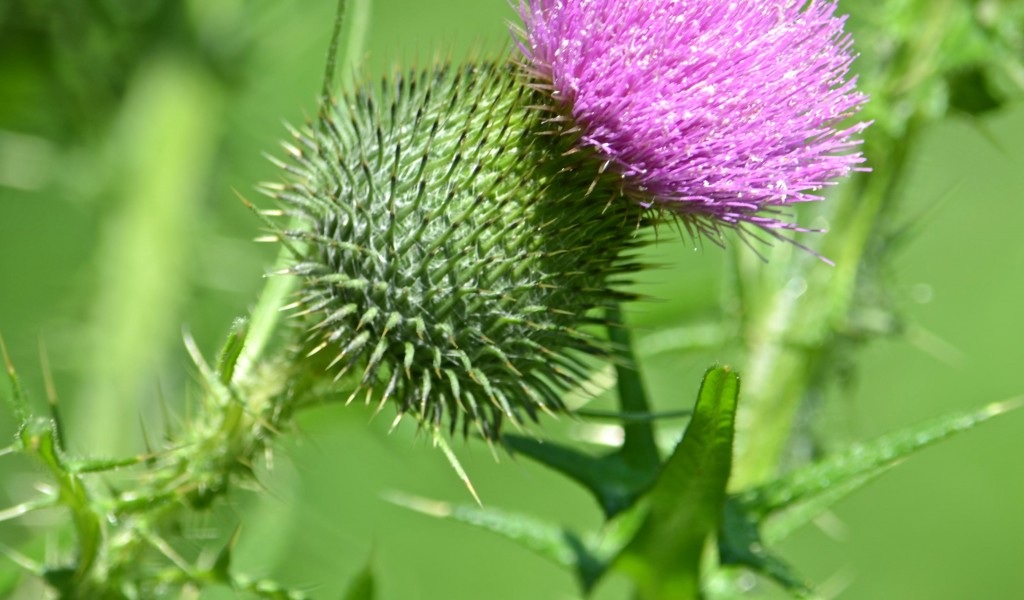About 6 feet tall and gangly. The seedheads release an anise scent if crushed. Aster family. Native.
Prairie Coneflower, Yellow Coneflower, Gray-headed Coneflower (Ratibida pinnata)

 In the meadow of wonders. This is about 6 feet tall and very prickly. A biennial that may only flower the second year. Unpalatable to grazing animals, but good nectar source for insects, and birds eat the seeds. You could peel, cook and eat the stems, or the tap roots of young plants, but my that would be a task. Native to Europe and Asia, considered a noxious weed in some states.
In the meadow of wonders. This is about 6 feet tall and very prickly. A biennial that may only flower the second year. Unpalatable to grazing animals, but good nectar source for insects, and birds eat the seeds. You could peel, cook and eat the stems, or the tap roots of young plants, but my that would be a task. Native to Europe and Asia, considered a noxious weed in some states.
Bull Thistle, Spear Thistle (Cisium vulgare)
Now I’m going to be posting the loads of plants all blooming in one place—Wilson Mountain—mostly in this amazing meadow, and a couple where I got lost back in the woods! Let’s start with Creeping Bellflower—apparently this is a bad invasive in some states, but it’s beautiful. I only saw a couple of plants. I wonder if next year it will try to take over the meadow. Campanula family. (Campanula means “bell.”) Native to Europe and western Siberia.
Creeping Bellflower, Rampion Bellflower (Campanula rapunculoides)
I thought of Goldenrod as a sinister figure in the hay fever department, but apparently the pollen that causes allergy problems is mainly from Ragweed, which blooms at the same time but is pollinated by the wind. Goldenrod pollen is too sticky and heavy for wind pollination so it relies on insect pollination. They are popular garden plants in Europe, and roadside weeds here. It contains rubber, and Thomas Edison experimented with making goldenrod a practical domestic source of rubber. Aster Family.
Goldenrod (Solidago altissima)
3-10 feet tall. This is an early stage of blooming. Foliage bright red in autumn. The fruit can be made into a lemonade-like drink, but make sure you aren’t using the related plant, POISON sumac. The leaves and berries were mixed with tobacco and smoked. Also used as a dye. Cashew family. Native.
Staghorn Sumac (Rhus typhina)
I posted about this flower previously and when I researched it, I found out that it sometimes has a tiny dark red flower in its center, supposedly to attract insects (but it’s so tiny, would they really notice?) So when I saw this group of plants, I checked, and some did have this little flower, tiny and almost black– see it?. (It’s the drop of blood where Queen Anne pricked her finger while making lace.)
Queen Anne’s Lace, Wild Carrot (Daucus carota)
At the Arboretum, even their weeds are impressive. This bloom is at eye level. This is how it appears during the day, and will open fully at at dusk. Each bloom only lasts until the following noon. In the second picture you can see how the buds snuggle into the leaves. As usual, it’s edible (the leaves) and was used medicinally (to heal bruises and wounds). Evening Primrose family. Native. (The day I took this, I found about a dozen new plants to add. I need an “I brake for wildflowers” bumper sticker.)
Common Evening Primrose, German Rampion, Hog Weed, Fever Plant (Oenothera biennis)